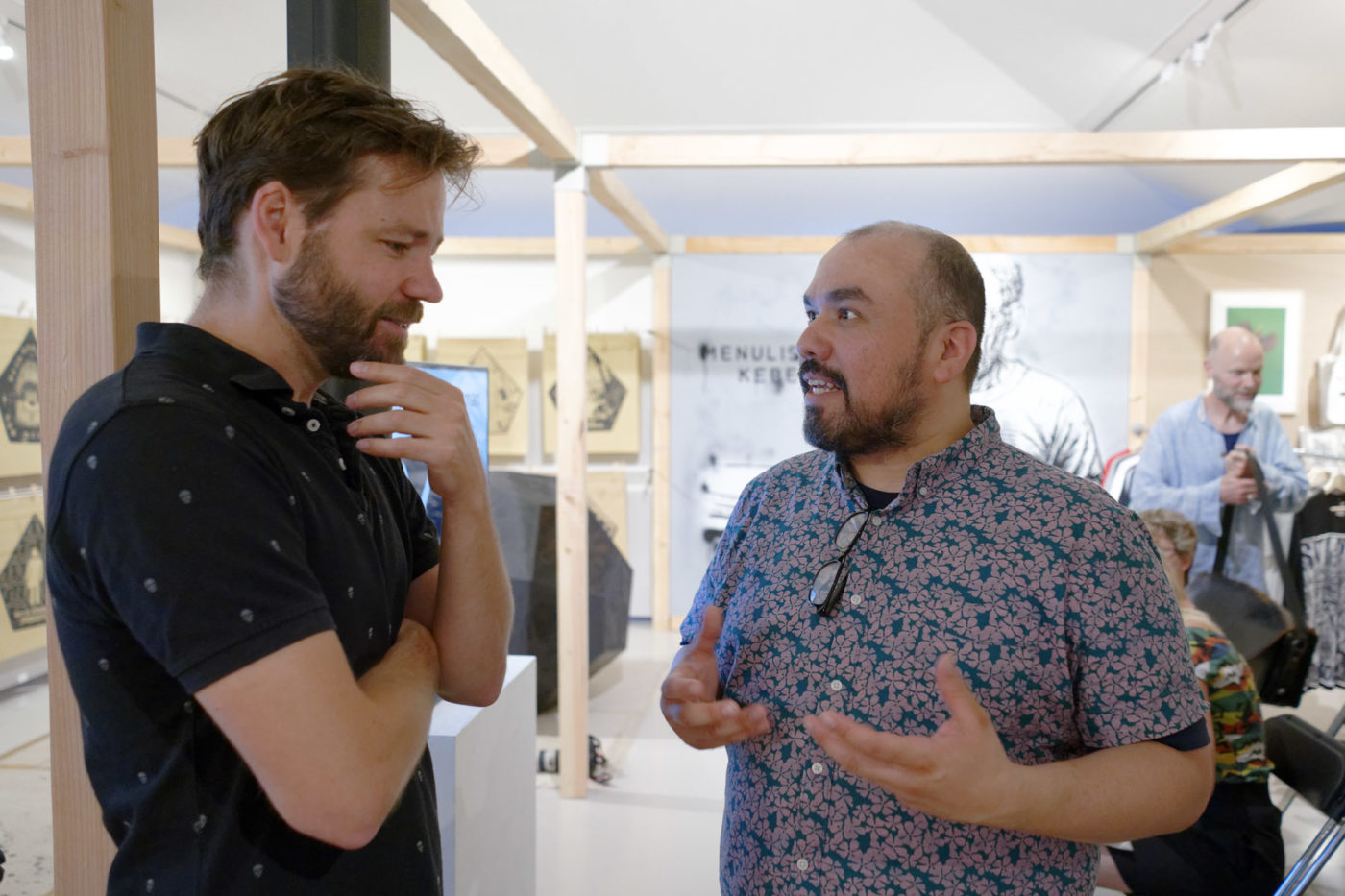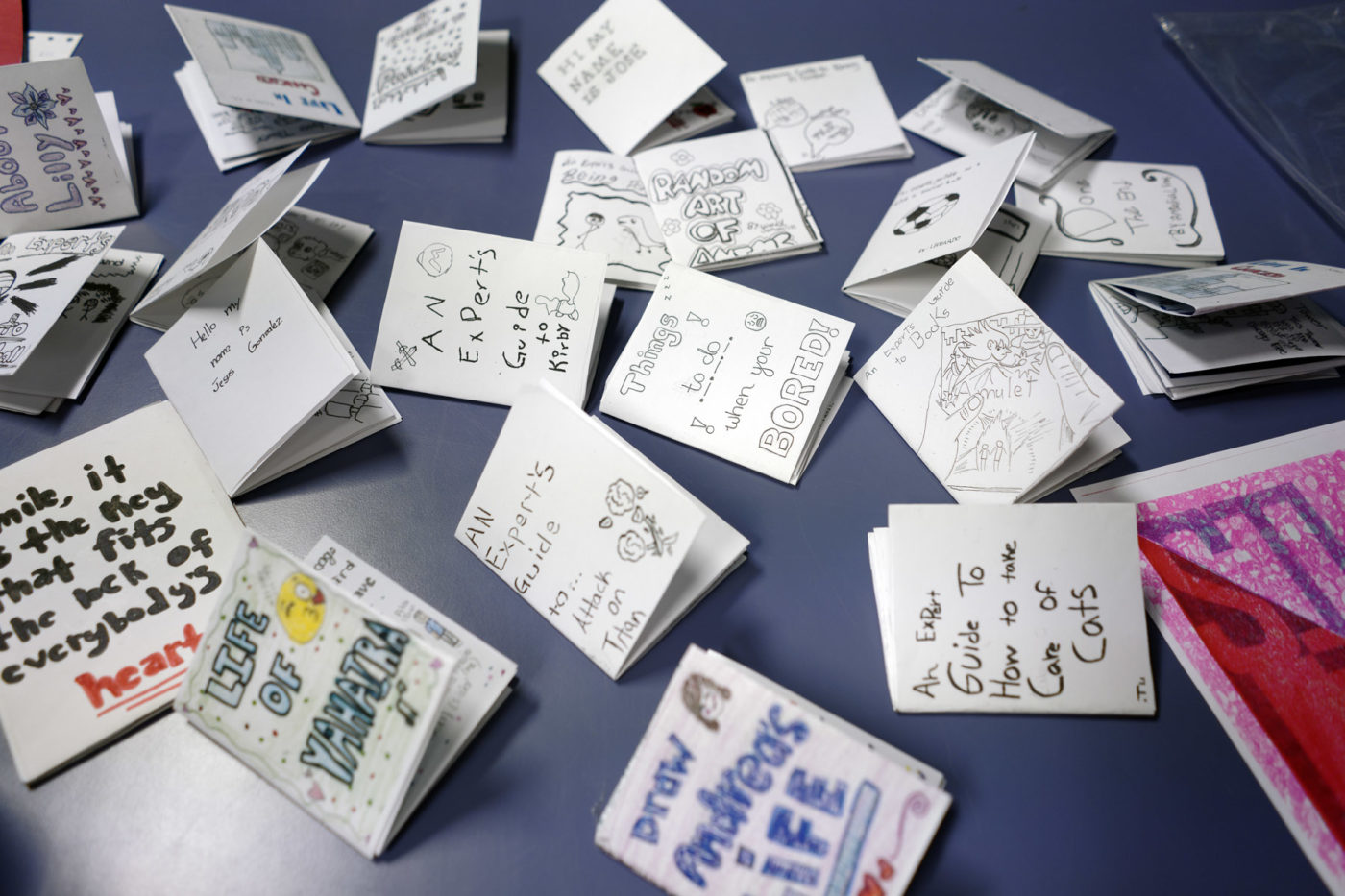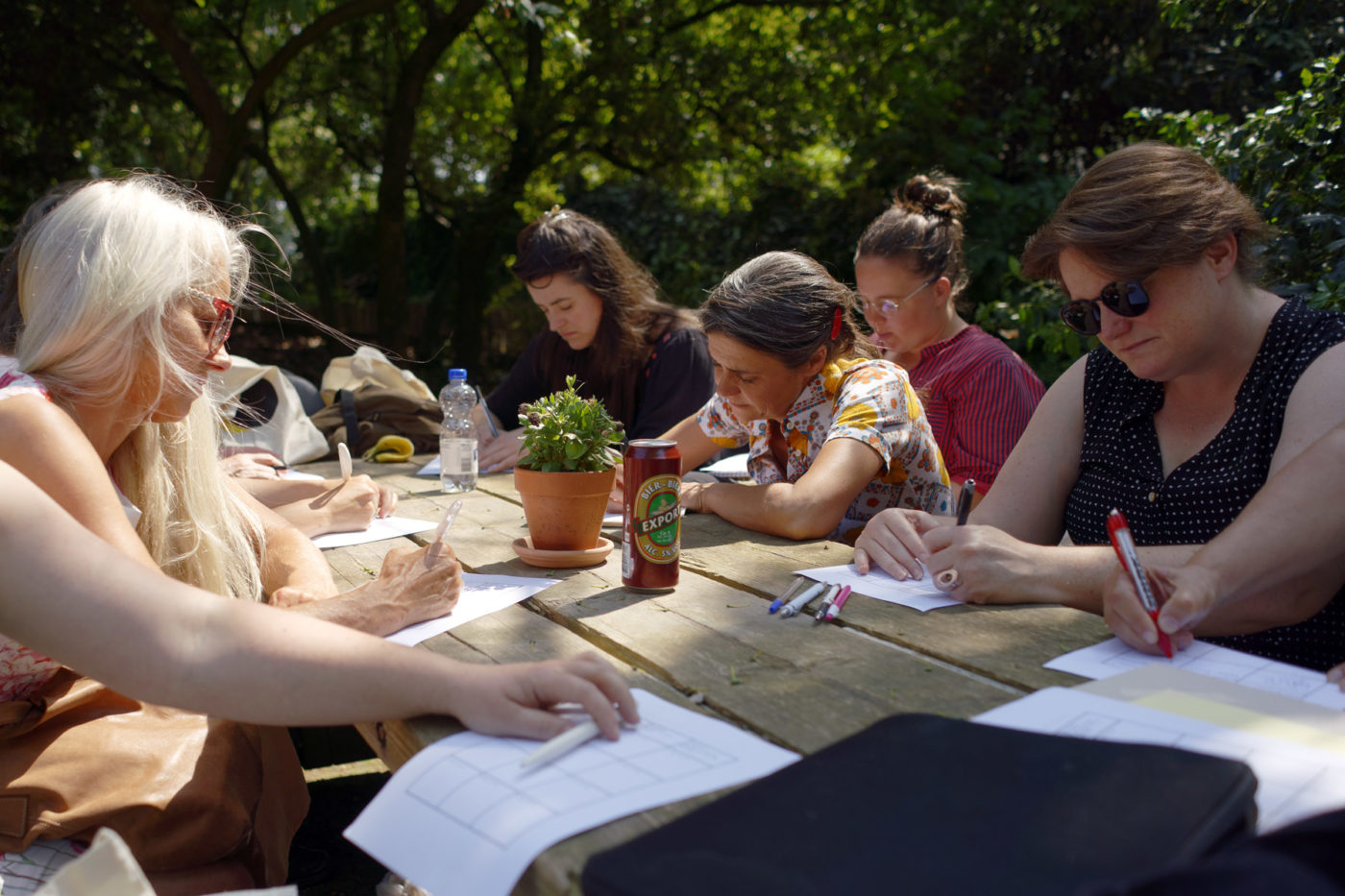Interview: Docent als conceptueel kunstenaar - Jorge Lucero
Teacher as conceptual artist is a research project initiated by the Research Group Arts Education of the Amsterdam University of the Arts. The title of the program was coined by Mexican-American artist and educator Jorge Lucero, whose practice has been dedicated to exploring the boundaries between being a teacher, a performer, and a conceptual artist. For four months Jorge worked, cooked, ate, skyped and continuously communicated with a group of Arts Education students, delving into the overlaps between teaching and artistic practice. The results of the project were shown in a symposium and a two-day exhibition, both taking place at Framer Framed, respectively on May 26th and the weekend of June 2nd and 3rd, 2018. On the day of the symposium Jorge showed up wearing a checkered pink-and-teal shirt, matching the foldout publication that resulted from the Teacher as conceptual artist project. Here was a man who truly was an embodiment of his work.
Jorge’s conversation, during his lecture at the symposium and while installing the exhibition, was often sprawling, covering endless references from artists, artworks, and theorists, to talking about musical influences and food. In Jorge’s vision, everything can be related back to his practice as an artist and teacher through the lens of conceptual art. The following text consists of several fragments from a conversation during Jorge’s last day in Amsterdam.
Where does Teacher as conceptual artist come from? How has it developed, or how does it work as a method?
Well, it’s not a formula, nor a coded system of behaviours. Teacher as conceptual artist can be described as an attitude or a way of thinking, and consequently a way of living in the world. It really likes to challenge the notion that certain kinds of productivity need to be enacted in order for you to be considered a ‘serious artist’. It tries to challenge what it might mean to be an artist. I was trained as a studio practitioner, but when I became a teacher my obligation as a teacher became so strenuous and time consuming that it was almost impossible to continue my studio practice in the same way that I had done before. At this point I had started having a family, and I happened to see a video of an interview with James Turrell talking about the Roden Crater, which he’s been working on in Arizona for decades now. The interviewer asked Turrell what did it cost him to make this artwork, and Turrell joked that it had taken him ’two marriages and a relationship’. When I heard that it really startled me, because I love my wife and I love my children very much, and I thought that was too high of a price to pay. At the same time, though, I’m an artist, and I want to investigate the world through the mechanisms of art. So I had to figure out another way to do it. […] I decided that I was going to see how much less I could do and still be making work. I was really inspired by the Lucy Lippard quote [in The Dematerialization of Art, regarding artists producing artworks from nothing], ‘We still do not know how much less nothing can be’. I’m really interested in seeing how little you can do and still get away with calling yourself an artist.
During your lecture you related every mode of your practice to a large amount of artworks and artists, often mentioning the ‘permissions’ given to you by conceptual art. Could you expand a little on what you refer to by these ‘permissions’, and how they have influenced your teaching?
Our imagination is very limited most of the time, but I think when we see things our imagination is expanded. So the first time I saw someone make art with their body, all of a sudden my brain said ‘You can make art with your body?!’, and the answer was right there, and the permission is given to me. So now I have permission— maybe I won’t use it, but…
But the possibility now exists…
Right! The possibility now exists. I never thought I could make art out of, for example, taking notes, or [out of] watching my students during recess, or eating with somebody. When I saw Rirkrit Tiravanija’s work I thought ‘Oh, you can eat with someone and make that an artwork?’. And then when I saw Joseph Beuys giving a lecture I thought ‘Hmm, maybe when I give a lecture that can be an artwork’. So that’s what I mean by ‘permissions’. If you study conceptual art, it gives you permissions to take what you do as a teacher and turn them into the things you make your work [as an artist] about. This is really what opened up the pathway for Teacher as conceptual artist, because I started looking at all of the behaviours that teachers do, especially the ones that they hate to do, and instead of me thinking ‘Oh, I really hate these behaviours,’ I started thinking ‘how are they material?’ That’s where this phrase, ‘Make School Material’ comes from, because my whole thought is ‘How do I look at the things that I am already doing at the school, and think of those as something that can be made pliable, that can be bent and made soft and rethought?’.
You mentioned that Teacher as conceptual artist started as a ‘creative survival mechanism’ for yourself, as a way of accommodating your life as an artist and as a teacher. However, you were still working inside an educational institution. What does context mean for developing such a project, especially when it means developing Teacher as conceptual artist with art spaces or educational institutions?
When I think of institutions I think of them as anything that puts parameters around the natural wildness of something. School and education is obviously not the same thing. You can get an education through hanging out with a street gang, and you can get an education through watching television. We learn in many different ways. It’s sort of natural, and it grows in whichever direction it grows in. The ‘institution’ or ‘school’, puts limitations on that. It puts parameters on it. And this is actually key. For me those parameters, and how specific they are to that place, that’s the material, because it’s a point of resistance. It’s as if you take a piece of metal and you’re trying to make it into an arc, for example. You have to figure out at what point the heat is going to bend the metal, how much pressure you have to put on it, what kinds of tools you need to be able to bend it. These are just questions of resistance. The material exists in the world in some way, and at some point it resists because of physics, and then humans, artists, find a way to push the limits of the physicality in order for that thing to do something unusual. And that goes for everything: glass, clay, paint, the body… computers, digital bytes, every single thing that we may consider ‘media’. It exists in the world as a kind of material, even concepts, and then the artist tests the pliability.
The institution is the same thing, it’s a point of resistance. […] As an artist you just have to find where the pliability is, you push it wherever you want it to go, you see what the potential outcomes are going to be. You also have to fail a lot, because the testing of the pliability sometimes means you push it too far and you break it, or sometimes you don’t push it enough and it doesn’t have any power.
For the project’s exhibition you worked for a couple of days with the Framer Framed team, and even participated in a panel discussion at Perdu on May 31st with one of its founding directors, Josien Pieterse. Do you find any commonalities between Framer Framed’s way of working and Teacher as conceptual artist?
The thing about institutions is that, as solid as that word sounds, institutions are made out of people, and… people are soft. I don’t mean that as an insult. What I mean is that they’re soft in the sense that if you treat the situation right they will move for you, or they will move with you. […] What I find great about Framer Framed is that it’s a place where that softness is at the core of its mission, or at least that’s what I get from the exhibitions that I’ve seen but also from the people that I’ve met. In some ways the objectives or the heart of Teacher as conceptual artist but also myself and Framer Framed are very clear in this sense.
When I look at a place like the Stedelijk Museum Amsterdam […] I am interested in seeing how organic an institution of that size can be. I imagine that it’s difficult. It’s basically the idea that it is more difficult to steer a very large boat, so… I like small boats (laughs). I think you can be a small, but powerful boat, and there are some advantages to having some independence, to being able to move and move quickly, to adapt to change and whatever is happening at any time. The 10-year sustainability of a project like Framer Framed could in fact be connected to the fact that it has understood its ‘size’. I am not talking about size of impact, or amount of activities. I’m really just talking about trying to keep it local, even if Framer Framed has an international reach. Paying attention to this, to the space between you and me […] there couldn’t be anything more local than this moment, or working together to build an installation, and [having an] attitude to work together alongside each other. The humanness of that, I think is also at the core of Teacher as conceptual artist. When you get rid of that, when it becomes much more ‘institutional’, it means usually that it’s large, and then I think you’ve got a problem.
You’ve mentioned working alongside each other, and this has actually raised some questions in the last week. Is there an effort for horizontality, or at least avoiding hierarchies; a democratic aspect of Teacher as conceptual artist? What are your thoughts about the role of collaboration? How do you enable horizontality with students and participants within this project?
I think there’s a projection made into it by other people, or by people who see […] anything that is [related to] contemporary art that tries to cross into the realm of education. This crossing over is seen as needing to be obligatorily democratic, or obligatorily horizontal. The reason that I have a hard time with this is that I wasn’t thinking of how to make a more just situation in my classroom so that everybody has a voice or participates. I wasn’t thinking about horizontality, I was thinking about creative practice within the constraints of the institution.
Now, the reason I can sleep at night, even though I’m doing this (laughs) is because, as a teacher, the thing that I care the most about is my students’ empowerment. That work is usually an invisible work. It’s something that’s impossible to document. You can take the exhibition at Framer Framed as an example: that comes from a four month collaboration, and the work that we’re showing at the exhibition space is maybe one fourth of everything that we did together, yet it definitely doesn’t capture the actual exchanges that we had with the students, the relationships that were built, and that will continue. It’s an impossible thing to show, but not an impossible thing to see, because in the span of five, ten, twenty years, you see the results of all the time you spent together, even though there’s no way to show that.
So of course you wouldn’t be able to encapsulate everything into an exhibition or a text… You are blurring the distinction between conceptual art and education, but it’s also blurring the line between conceptual art and life.
Yes, and my hope [for Teacher as conceptual artist] would be that other artists and other teachers can look and listen and read about it, and that they will think for themselves not ’this is what I have to do’, but that their imagination will be expanded in the same way we were talking about with the ‘permissions’. I hope that they would be able to say ‘I don’t need to be a teacher who suffers’, or ‘I am a teacher-artist who suffers because I have to spend 10 hours a day at school’. You can rethink the way that you exist in the school, and maybe that will also help you rethink the way that you exist outside of the school. The hardest thing is to think that your ‘school-life’ and your ‘real life’ are two separate things. There’s just not enough time in the day to have two different existences; you can be a hybrid person, but you still have to be one person.
- Interview by Jean Carlo Medina
Community & Learning / Educatie / Social Practice /
Exposities

Expositie: Teacher as conceptual artist
Tentoonstelling en symposium ism. Jorge Lucero en het lectoraat Kunsteducatie van de Amsterdamse Hogeschool voor de Kunsten
Agenda
Symposium: Teacher as conceptual artist
Georganiseerd door de Amsterdamse Hogeschool voor de Kunsten op 26 mei (symposium) en 2 & 3 juni (expositie).
Netwerk

Jean Medina
Kunstenaar


















